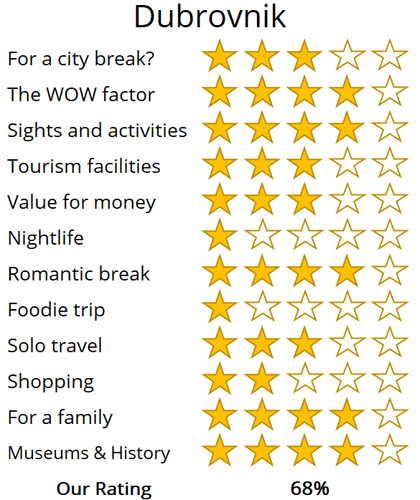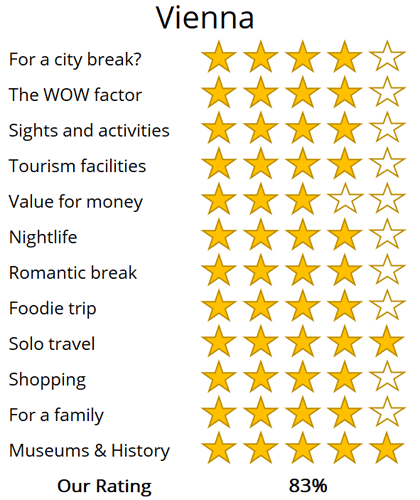WhereToGoForMyHoliday.com
The best destination comparison site!
WhereToGoForMyHoliday.com
The best destination comparison site!
Dubrovnik or Vienna, which is better for your holiday in 2024?
Dubrovnik and Vienna both offer unique and enticing experiences, but which one should you choose for your city break or holiday?
We recognise the difficulty in making this decision. While there is abundant information available on both destinations, clear guidance on which city better aligns with your travel preferences is often hard to find.
This article aims to provide an impartial comparison of Vienna and Dubrovnik, and hopefully help you to choose the best city to visit.
The article is structured into several sections, each of which can be directly accessed through the following links:
• Introduction to the cities
• Scores and ratings
• Which one should I, friends, or family visit?
• When to visit and weather
• Who is the city suited for?
• The perfect 48hours (with map)
• Tourism details (where to stay? airport details?)
Introduction to Dubrovnik and Vienna
Dubrovnik, a jewel of the Adriatic, beckons modern travellers with its sublime blend of medieval charm and contemporary allure. Encircled by iconic stone walls, this UNESCO World Heritage site offers a timeless journey through cobbled streets and baroque buildings, each telling tales of a rich, turbulent history.
Yet, beyond its historical treasures, Dubrovnik embraces the present with open arms, offering a plethora of chic restaurants, trendy boutiques, and vibrant nightlife. The stunning coastline, dotted with pristine (stone) beaches and crystal-clear waters, provides a tranquil escape from the city’s bustling heart.
For the discerning traveller seeking a blend of culture, history, and natural beauty, Dubrovnik stands unrivalled—a truly captivating destination.
The erstwhile epicentre of the great Habsburg empire, Vienna, is just as grand and glorious as you might expect. The Hofburg palace spreads is vast Baroque wings in the heart of the town, framing manicured gardens topped with equestrian statues. There's the Belvedere, a patchwork of orangeries and old court rooms. There are opera houses and theatre rooms and the elegant façades of the Schönbrunn. It's enough to keep the camera a-clicking for several days.
But Vienna isn't only about 18th-centry grandeur. This is a lived-in European capital. It's got gritty nightlife districts that offer up beating boat bars on the Danube. It's got handsome parks packed with pine forests and duck ponds. There are vibrant markets with food from all around the globe. And you've got one of the world's most active café cultures, with coffee shops where the likes of Freud and Trotsky were once regulars.

The classic skyline view of Vienna from Saint Stephen’s Cathedral, with its uniquely tiled roof
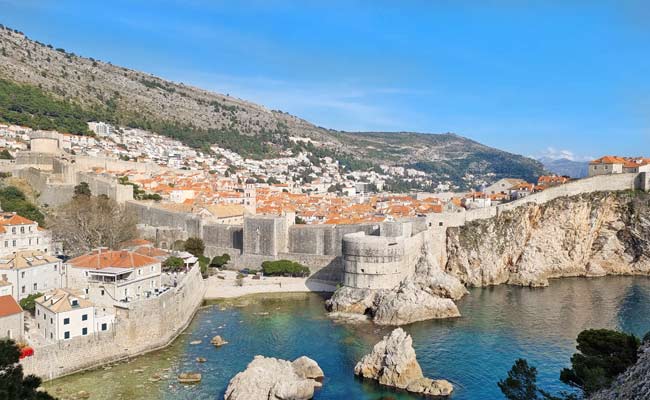
Dubrovnik is one of the most picturesque cities in Europe, so long as your happy to share the experience with thousands of other tourists.
High-level summary for Dubrovnik and Vienna
Summary
Where would I journey for a personal escape?
Vienna
Where would I send my parents for a memorable visit?
Vienna
Where's the ideal destination for my adventurous 19-year-old cousin?
Vienna
Where should my food-obsessed friend indulge their culinary passions?
Vienna
Note: The above comparisons are weather-independent and are based on travel during the most opportune times of the year. Details about the ideal travel seasons are elaborated upon later in this article.
In the sections that follow, you'll find a comprehensive comparison between these two fascinating cities. This includes recommendations on the duration of stay, the best times to visit, and tailored 48-hour itineraries for each city.
The final segment delves into practicalities for your travels, such as the best airport to fly into, the optimal districts for your accommodation, and insider tips, for when you come to explore the city.
We hope that you find all of this information useful, in planning your next exciting trip!
Destination details
How long to spend each city?
Vienna is big and brimmingwith sights. History buffs and culture vultures will want at least three or four days to check off the bucket-list attractions. That's because the mainstay palaces and the most immersive museums each deserve at least half a day to themselves. You'll also need some time to wander the Old Town area and hop the famous Viennese cafés.
If you're eager to explore all of the facets of Vienna, then you'll certainly need much longer than just your average city break. Whole weeks can be spent enjoying the buzzy squares and the statue-filled parklands. What's more, there are day trips aplenty in the region, ranging from the pine forests of the Wienerwald to the rising foothills of the Salzburger Alps.
Choosing how long to spend in Dubrovnik really depends on what you want out of your city break. A fly-in whirlwind tour of the Old Town can be great if you're on the hunt for culture and history. The museum collections of the Sponza Palace and the Rector's House, walking routes of the City Walls, and sightings of landmarks like Large Onofrio Fountain can all be packed into just a day or two.
But it might be best to allow a little extra time. With all the castles and churches here, it's easy to forget that Dubrovnik is an Adriatic riviera destination at heart. You've got pine forests, olive groves, rakija distilleries and the lost-paradise island of Mljet to think about. You certainly won't want to rush those during the warmer months, so consider staying a week or more to explore the city itself and those stunning surroundings.

The Schönbrunn Palace, Vienna one of the grandest palaces of central Europe
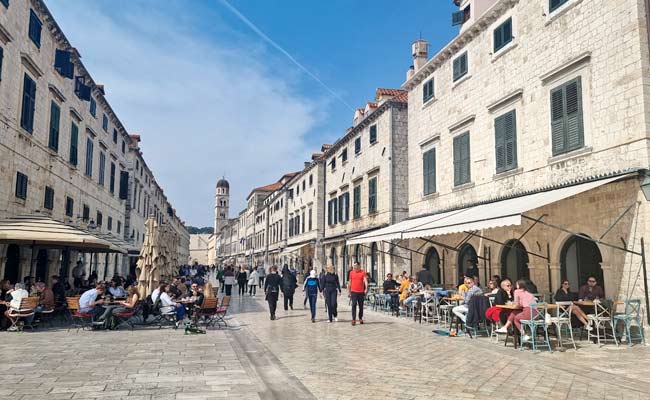
The Stradun is the characterful main street of Dubrovnik
Vienna in the summer can't be beaten. When the sun shines, the city's parks and bars come alive. The best weather is usually between June and August, but beware that things can get hot and humid, with temperatures cranking up over 30 Celsius. The good news is that there are some strands and swimming spots along the Danube for cooling off. If you prefer things a little milder, May and September are usually also dry and warm.
On the flip side, Vienna in winter is a real wonderland. The Austrian capital hosts some of the most enchanting Christmas markets in Europe. You'll find those brewing up hot chocolates and mulled wine on Rathausplatz and in the grounds of the Schloss Schönbrunn. They get into full swing in December, when it's common to get dustings of snow and sub-zero temperatures – boots and woollies will be required.
Summer might seem like the perfect time to put together a trip to Croatia's castle city. However, temperature highs in the low 30s and strong midday sun can make things a little tiring. And that's not even mentioning the whopping great big crowds. Recent protests by Dubrovnik's locals have really highlighted the problem of summertime tourism – there's hardly an inch to move in the Old Town, especially when huge cruise ships are docked at port.
Things might improve thanks to recent laws barring any more than two large vessels per day, but we still think September and October come up trumps. This southern corner of the Balkans stays pleasantly warm well into the autumn, so you shouldn't have to worry about having the weather to laze on Lapad Beach. What's more, visitor numbers, hotel rates, and flight prices all plummet following the end of the summer vacations.
Packing in handsome palaces, Austrian beer houses, Alpine forests, cool cafés, art-filled galleries, and a buzzy nightlife, Vienna satisfies all sorts of travelers. You can easily fill whole trips in the museums alone. Days can be whiled away flitting between coffee shops. Nights can be spent in opera shows or glugging frothy beers in hipster bars.
Don't go thinking that Vienna is the great Austrian outdoors. This might be the country of the Alps, but the mountains are still at least an hour's train ride to the west. What's more, there's not a beach in sight. The best that landlocked Central Europe can offer in the way of sand and water is a few artificial swimming areas along the River Danube.
If you're one for enthralling tales of warring republics and battles with the Ottomans, Dubrovnik has you covered. If you're the sort who loves jaw-dropping European old towns with enough castles and churches and cobbled alleys to keep you going for a whole trip, it's also perfect.
Oh, and Dubrovnik takes care of globetrotters who come in search of a little Mediterranean sand, sun and sea. You won't have to venture far to find a cove to swim in, a yacht charter, or even a remote island villa where you can crank up the R&R.
If you're not big on crowds, then summer trips (as noted above) to Dubrovnik are surely best avoided. And it's hardly the place for anyone in search of big-metropolis vibes. For a city, Dubrovnik is relatively small and compact.
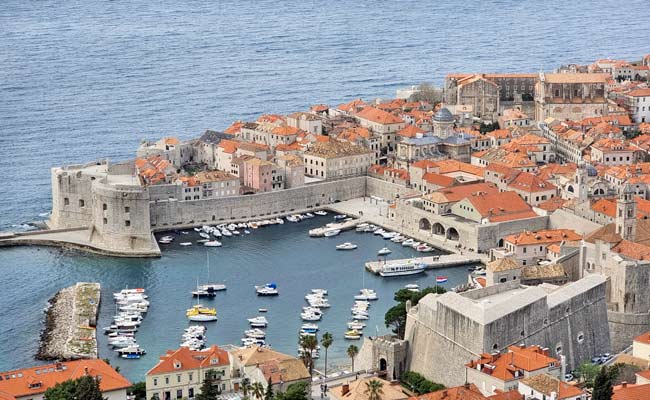
The pretty harbout of Dubrovnik

The cascade fountain at the Belvedere, Vienna
48hours in Dubrovnik
Hopping from crenulated towers overlooking the Adriatic Sea to hidden local swimming spots to soaring summits in the Dinaric Alps, this fun-filled 48 hours could just be the perfect introduction to this awesome city:
Day 1: Start – where else? – on buzzy Stradun. The main artery of the Old Town of Dubrovnik, it runs from the port to Pile Gate (a 16th-century stone gatehouse that's worth a photo stop), passing Irish pubs, coffee joints, and Croatian konoba (taverns) as it goes. Sip a cappuccino and devour a pastry there before making for the Large Onofrio Fountain.
An elaborate water feature that's stood since the 1430s, it still dispenses crystal-clear water for drinking. Fill the bottle and then move to the iconic City Walls. These can be traversed entirely.
You can choose to do them on a guided tour (a Game of Thrones tour is available) or by yourself. In all, the whole stroll takes around two hours from start to finish, covering two kilometres of fortifications that include glimpses of famous citadels like Fort Minčeta (1319) and the dungeon-like Fort Revelin (now home to an EDM nightclub – remember that for later!).
For the evening, retreat to the legendary Buža Bar. It gazes straight out southwards across the Adriatic Sea. You can watch locals diving from the rocks into the water as you sip your sundowner beer.
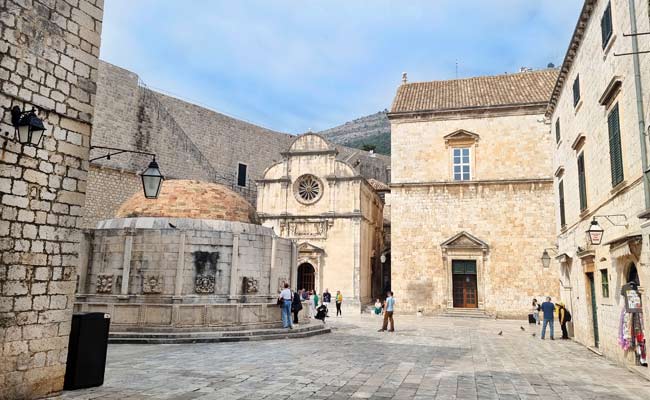
The Onofrijeva fountain and the towering city walls of Dubrovnik
Day 2: Kick start the day with a dip in the Med at Banje Beach. This is the closest beach to the Old Town of Dubrovnik and has a free section where you can take a quick swim while gawping at the high fortresses overhead.
Cafés and gelato shops line Frana Supila just above it, where you can grab a bite for breakfast before making for the base station of the Dubrovnik Cable Car – it's less than 500 metres away. Tickets might cost 170 HRK (€22) apiece, but the sweeping 180-degree views from the top station of Mountain Srd are simply awesome.
You'll be able to see the red-tiled roofs of the Old Town below, the wooded crags of Lokrum Island, and the remote Elaphiti Islands (perfect day outings by boat if you have some more time to spare) beyond.
Return to ground level and then hop on a bus going over to the Lapad Peninsula. This is great for the evening. A quick splash in the sea can be followed by uber-fresh seafood dinners with crisp Croatian wine in the traditional taverns just by the bay.
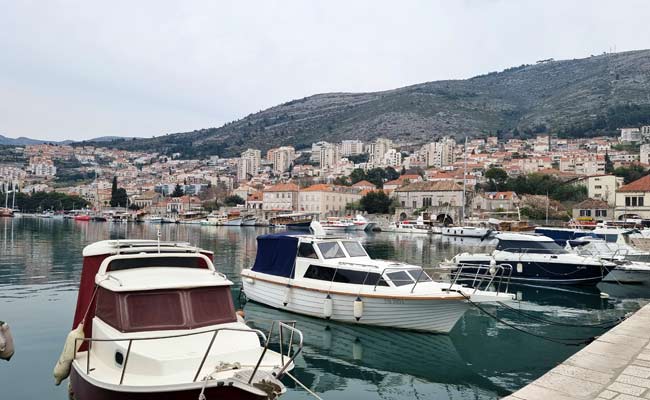
The New Town of Dubrovnik is centred around the harbour
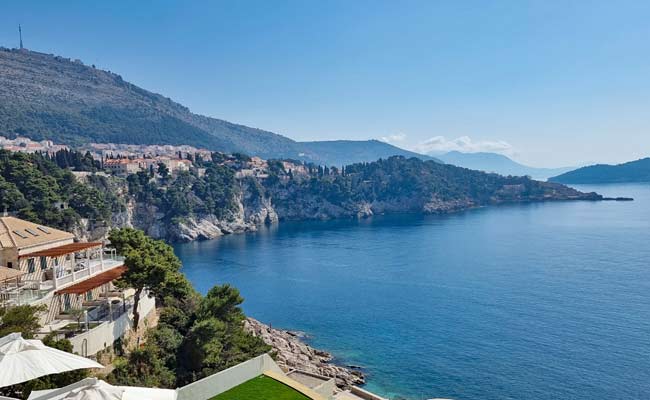
The dramatic coastline to the west of Dubrovnik Old town
48hours in Vienna
So, you only have two days in the Austrian capital? Get ready for an itinerary that's packed to bursting with all sorts. From Neo-Classical Habsburg mansions to strolls on the Danube canals to mornings in buzzy market areas, there's something for a whole host of traveler types in these parts.
Day 1: Morning on the Heldenplatz. This manicured urban garden is one of the most iconic squares in Vienna. The huge equestrian statue of Archduke Charles of Austria is what will probably catch the eye but remember that the plaza was also the place where Hitler announced the annexation of Austria in 1938. Nearby, the Hofburg stands proud.
On a quick, two-day itinerary, it's probably best not to delve inside. The exhibits can easily take hours on end, though it's a must if you're a lover of 18th-century European history. Take your photos of the mighty Neo-Classical exterior and then move straight to the streets to the west. They herald the Innere Stadt (the Old Town) of Vienna. Cobbled lanes and little archways form a maze here that's lovely to get lost in. A lunch stop (read: strudel stop) at Café Central is a doozy. Gold-leafed ceilings and elegant royal portraits gild the interior, though the main draw is sitting where Freud and Trotsky once sat sipping their coffees.
Later on, head north around the ring roads to the Sigmund Freud Museum. It's a fine introduction to the life and works of the founder of psychoanalysis, with the original doctor's couch that his patients would sit on. Beeline straight to Prater when the evening closes in. You can get there on the underground, emerging into Vienna's famous inner-city theme part with its twirling Ferris wheel and fairground attractions.

The Prater amusement park with its traditional rides and the Wiener Riesenrad Ferris wheel
Day 2: The early hours on the Naschmarkt offer some of the best people watching in the city. Fruit sellers call out prices while locals chow down on pretzels and white beer in the stalls. This vibrant bazaar is also the perfect place to grab any Viennese souvenirs and foodstuffs. A ubiquitous fix of palaces comes next. We'd recommend choosing one of the big two – the Belvedere Palace or the Schönbrunn. Both are stunning but the former is the easiest to get to. Both will also likely take a couple of hours, especially if you want to explore the sprawling grounds as well as the interior court rooms of the old Habsburg elite.
That will still leave some time in the afternoon to breeze over to the Danube Canal. Abuzz with boat bars and hole-in-the-wall eateries, it can help balance out the culture with a little hedonism. The district of Leopoldstadt is right behind, replete with hipster coffee joints and cocktail emporiums. An alternative way to cap off your weekend could be a jaunt to the hills of the Vienna Woods (the Wienerwald). They offer lookouts – and gorgeous sunsets – above the capital just behind the area of Hütteldorf.

Vienna is not just historic relic, there are modern curiosities such as the Hundertwasser House, designed by an artist who wished no straight lines in his building......
Vienna is among the safest and most liveable cities in the world – at least if the stats are to be believed. Of course, you'll need to have your wits about you as if you were traveling anywhere. Pickpocketing, fake tour guides, and taxi scams do occur, though they aren't common as in other European capitals.
Getting around should be a cinch in the Austrian capital. The U-Bahn is ridiculously efficient. It links with above-ground rail lines and trams on a single-ticket network to make going from A to B a pleasure, not a chore.
Single trip fares sit at €2.40, while a 48-hour travel card costs €14.10. Don't be tempted to ride the subway without buying tickets. This is possible because the platforms aren't gated, but there are regular checks and hefty fines to match.

The Gloriette is situated on one of the highest points of Vienna and provides one of the best views of the city and the Schönbrunn Palace.
The best arrival point for those flying is Vienna International Airport. It's a well-equipped, modern port on the south-eastern side of the capital. Direct S-Bahn trains link the centre to the terminals, or you can hop on the premium Railjet from Vienna Hauptbahnhof. There's also a shuttle link provided by AirportLines Bus, costing €13 per person, return.
Picking hotels in Vienna can sometimes be a tricky business. First-time visitors can't go wrong if they aim to stay in the Old Town (the Innere Stadt), but rooms there can be pricy and sell out fast. Good alternatives include the hip and happening district of Leopoldstadt (great for dining with a youthful vibe) and any of the blocks that come off Naschmarkt.
You'll want to arrive and depart from Dubrovnik Airport if you're coming on a quick city break. It's located just over 15 kilometres from the heart of the city. Shuttles run regular routes from the Old Town and the Kantafig bus interchange to the airport terminals. The journey takes around 45 minutes to an hour in good traffic and costs between 35-55 HRK, depending on the operator you choose.
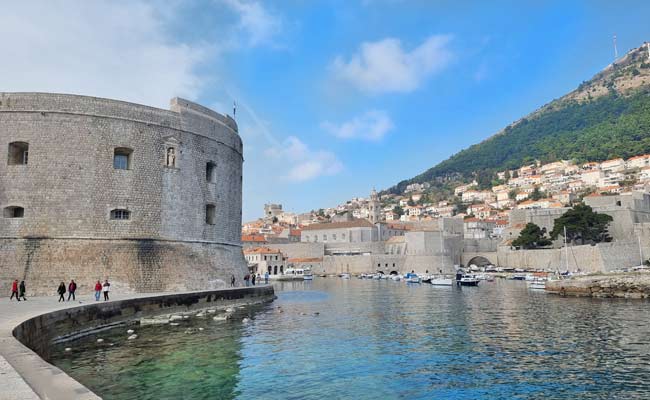
The entrance to Dubrovnik harbour
Dubrovnik is a super walkable city. In fact, getting lost in the Old Town area is one of the best things to do here. Don't go thinking you can use the City Walls to navigate. The ticket for those costs 200 HRK (€29) and is only valid for a single entry.
To get back and forth from districts around the Old Town and the beaches of Lapad and beyond, there's an efficient local bus network. Virtually all routes will either take you to the historic heart of Dubrovnik or terminate at the main Kantafig station. You can purchase fares onboard for 15 HRK but they're a little cheaper if bought from a kiosk in advance.
Try to seek out a place to stay as close to the Old Town as you can if you're coming to see the history sights and enjoy the walking tours. Remember that the district is super compact, so boutique B&Bs with cosy rooms are the name of the game within its boundaries. For extra space and proximity to the Adriatic Sea, you could look to the larger hotels and guesthouses around Banje Beach or Gruz to the north.

oh we were stuck in the airport!

Copenhagen was a bit expensive...

All we did was drink beer in Brussels...

Muncih was crazy

And we got so burnt!

Remeber that night in Rome

oh we were stuck in the airport

So much fun kayaking

Berlin and that group from Austria!

There was such a view from that church

And we got so burnt!

Munich was eventful, wasn't it!

Such a view from that cathedral in Florence

Lisbon was such so much fun

Last summer was so much fun .... x

Remeber that night in Rome

Lisbon was such so much fun

Such a view from that cathedral in Florence

Munich was eventful, wasn't it!

And we got so burnt!

Remeber that night in Rome

All we did was drink beer in Brussels...

Berlin and that group from Austria!

Can't wait to go back to Dubrovnik

Remember that boat ride in Prague

Copenhagen was a bit expensive...
